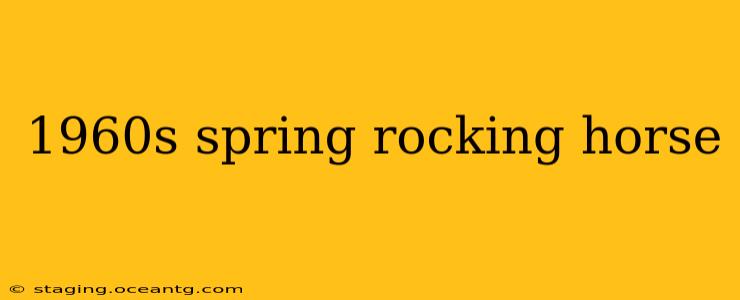The 1960s were a vibrant decade, marked by significant social and cultural shifts. This era's influence extended even to children's toys, with the spring rocking horse emerging as a beloved classic. These aren't your grandfather's wooden rocking horses; 1960s spring rocking horses offered a unique blend of playful design and innovative mechanics, capturing the spirit of mid-century modern aesthetics. This article delves into the charm and collectability of these iconic toys, exploring their features, manufacturers, and enduring appeal.
What Made 1960s Spring Rocking Horses Special?
Unlike traditional rocking horses, which relied on a rocking base, 1960s spring rocking horses utilized a spring mechanism for their rocking motion. This innovative feature provided a smoother, bouncier ride, adding a new dimension to the classic rocking horse experience. The springs were often concealed within the toy's base, maintaining a streamlined and aesthetically pleasing design. Many boasted vibrant colors, playful designs, and often incorporated whimsical features like oversized eyes and cheerful expressions, reflecting the optimistic mood of the era. The use of materials like molded plastic contributed to a more affordable and widely accessible toy compared to their handcrafted wooden predecessors.
What Were Some Popular Brands and Styles of 1960s Spring Rocking Horses?
Pinpointing specific manufacturers for every 1960s spring rocking horse can be challenging due to limited readily available documentation. However, several prominent toy companies of the era likely produced these types of rocking horses. Many were unbranded or bore the name of the department store where they were sold. Common styles included:
- Animalistic Designs: Horses were the most common, but you could also find spring rocking versions of other animals like ponies, deer, and even bears.
- Character-Based Designs: Some were modeled after popular cartoon characters or fictional animals, reflecting the influence of television and popular culture.
- Simple, Streamlined Designs: Many embraced the minimalist aesthetic of mid-century modern design, featuring clean lines and bold colors.
Identifying a specific manufacturer often requires close examination of the toy itself for markings or labels, which may indicate the origin.
How Much Are 1960s Spring Rocking Horses Worth Today?
The value of a 1960s spring rocking horse varies greatly depending on several factors:
- Condition: A well-preserved rocking horse in excellent condition, with minimal wear and tear, will command a higher price.
- Rarity: Unique designs or those from less common manufacturers are usually more valuable.
- Demand: The current market demand for vintage toys, and specifically 1960s spring rocking horses, influences pricing.
- Completeness: The presence of all original parts, such as the spring mechanism and any additional accessories, increases value.
Online auction sites and vintage toy marketplaces can offer insights into current market prices. However, it's crucial to carefully research comparable items before making a purchase or valuation.
How Can I Identify an Authentic 1960s Spring Rocking Horse?
Authenticity is crucial when collecting vintage toys. Look for several key indicators:
- Materials: Pay close attention to the materials used. 1960s plastic often has a distinct texture and may show signs of age (yellowing, slight discoloration).
- Construction: The craftsmanship may differ from modern toys. Examine the assembly and the quality of the paint or finish.
- Design Details: Specific design elements, colors, and features can help determine the era.
- Markings and Labels: Any markings or labels on the toy, however faint, can provide crucial information about its origin and manufacturer.
Comparing your potential find to images of known 1960s spring rocking horses online can be beneficial.
Are 1960s Spring Rocking Horses Safe for Children Today?
While these toys evoke a sense of nostalgia, safety is paramount. Before allowing a child to use a vintage spring rocking horse, thoroughly inspect it for any damage or potential hazards:
- Check the Spring Mechanism: Ensure the spring is securely attached and functions correctly. A broken or faulty spring presents a significant safety risk.
- Inspect the Paint: Lead-based paint was common in toys of that era. If there's any concern about the paint, it's best to have it professionally tested.
- Assess Structural Integrity: Check for cracks, breaks, or loose parts that could pose a risk.
If you have any doubts about the safety of the rocking horse, it's best to keep it as a collectible item rather than a child's toy.
Where Can I Find 1960s Spring Rocking Horses for Sale?
Vintage and antique toy collectors often frequent online auction sites (like eBay), specialized vintage toy shops, and antique stores or flea markets. Joining online communities and forums dedicated to vintage toys can also lead to potential finds. Be prepared to dedicate time to searching and comparing prices to ensure you're making an informed purchase.
The 1960s spring rocking horse is more than just a toy; it's a tangible piece of history, representing a unique era in toy design and reflecting the playful spirit of the decade. Whether you're a seasoned collector or simply appreciate the charm of vintage toys, understanding their history and features enhances their value and appeal.
